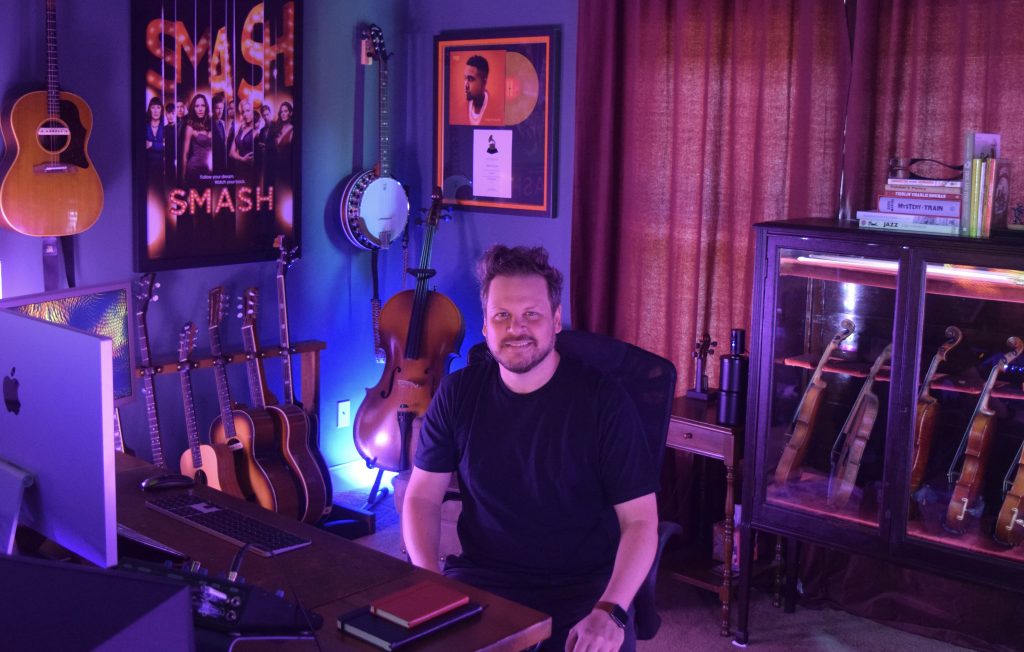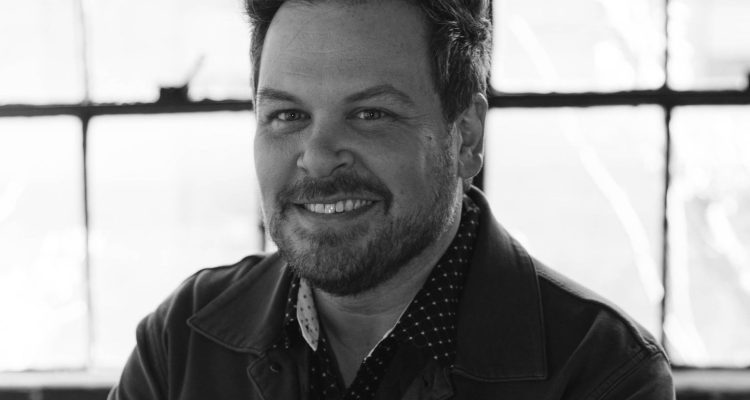Mark Evitts is an accomplished American composer, songwriter, and musician hailing from the riverboat town of Paducah, Kentucky. “It’s almost halfway between Chicago and New Orleans, so my musical heritage is of jazz and Dixieland,” shares Evitts. “Kentucky is also the home of bluegrass music and Appalachian folk songs… there’s a rich history of folk music and jazz. It’s a cauldron of these different American influences.”
Serving as composer and songwriter for Apple TV+’s newest animated series was a thrilling opportunity to delve into his musical heritage. Adapted from the best-selling children’s book, Apple’s animated “Frog and Toad” series has a wonderfully rich score from Evitts. The composer features Dixieland banjos and fiddles alongside swing clarinets and Hot Club guitar to weave the series’ musical tapestry.
Evitts career started as a road musician playing with country music artists, which led to songwriting credits including co-writing Nas’ single “Brunch on Sundays,” which he also performed on, from the Grammy-nominated album “King’s Disease II” and The Game’s single “Violence”.
In addition to his songwriting and composing work, Mark has served as an arranger and musician on several hit television shows such as NBC’s SMASH, notably on Emmy-nominated song “Voice In A Dream.”
As a multi-instrumentalist, Mark has also performed on prestigious stages worldwide, including The Grand Ole Opry and Carnegie Hall. Outside of music, Evitts also studied character development and comedy at The Groundlings, a comedy staple of the Los Angeles creative community.
Evitts spoke to Awards Focus about his process in crafting the music for “Frog and Toad,” from his collaboration with the director and producers to maintaining story tone through his instrument choices.
Awards Focus: The characters of Frog and Toad are known for their distinct personalities. How did you use music to reflect their individual traits and dynamics throughout the story?
Mark Evitts: One of the great things about working in this industry is the ability to collaborate. Not just with musicians, but the animators as well. I’ve had chats with Sarah Johnson who was the director of “Frog and Toad.” She and the other amazing animators spent so much time working on Frog’s walking gate before the animation had even begun. She had a vision for the walk and had thought about it and chiseled away at it for months so that when it came to me to write music for the series, I knew that I wanted to play off of that.
The pacing had a stroll to it that was upbeat and energetic, but not too on the nose “hopping” for a frog. So, I gave the character a gentle stroll that was upbeat. I would start by writing a basic drum pattern and bass that matched his rhythm and then add in all the colors of the rest of the instruments over the top of that.
With Toad, he was often very different from Frog, so I tried to encapsulate his personality with different patterns than Frog’s. Not to stop the music or make it stutter, but rather to emphasize his different perspectives oftentimes with the use of winds.
AF: Were there specific musical themes or motifs that you developed to underscore the friendship and camaraderie between them?
Evitts: Absolutely. One of the more fun things to write on the show was the montage moments where they worked together. I tried to always give these a similar old-time, early jazz feel. There’s one scene where Frog and Toad are baking a cake together.
Toad is teaching Frog how to bake the cake and wants Frog to do it on his own. As Frog is making a bit of a mess, Toad feels the need to come in and take over. Frog eventually steps back and lets Toad do all of the work. I decided to write this as a duet between piano and fiddle. The piano represents Frog and the fiddle represents Toad.
At first, the piano is playing the melody with a few sloppy hits here and there and the fiddle is in the background playing rhythm. The fiddle starts to become more present and the piano begins to fade out. Eventually, the fiddle takes over and finishes the song.
AF: How did you create a score that evoked feelings of nostalgia to the scores of John Barry and John Williams, while infusing jazz and folk elements?
Evitts: I’m from a riverboat town called Paducah, Kentucky. It’s almost halfway between Chicago and New Orleans, so my musical heritage is of jazz and Dixieland, but Kentucky is also the home of bluegrass music and Appalachian folk songs, and the closest city is Nashville, Tennessee.
So there’s a rich history of folk music and jazz. It’s a cauldron of these different American influences. After chatting with the executive producer, Rob Hoegee, and the team at Apple at length about the palette, we went in this direction.
The great thing about these styles of music is that they are simple yet sophisticated. I would start by getting the vibe and perspective of the character in the scene and then write what I thought felt like a folk melody or perhaps could be jazz standard and then whittle it down to work for the scene.
I would write the music first and then make it work for what was happening in terms of action. I feel like this approach helped me keep things simple but had the sophistication of an animated show and would sound right for what was happening visually.
AF: How does your process change when writing a musical score for an animated series? How does it evolve when you’re incorporating songs into the project?
Evitts: With this show, I did things a bit differently. Writing the song first and then fitting into the project was a bit tricky, but it seemed to work well with the animation. With animation, there tends to be a bit more action that needs to be paid attention to. I’m also thinking about how the emotions can’t go too dark in terms of overtones.
When I want to convey something that’s a bit heavier, I tend to use winds, as it is still light but can convey some tones of sadness with a clarinet or bassoon. Whereas, if I was scoring for a drama I would use darker strings. For me, it’s all about remembering that Frog and Toad are on an adventure together, and the ride, while having ups and downs, needs to be a fun adventure.
AF: Can you share some insights into your collaboration with the director alongside the rest of the project’s crew to achieve the desired musical atmosphere for the production?
Evitts: When I get an episode of “Frog and Toad,” I usually watch the entire episode first and make notes about what instruments or tempos might highlight the action and the story arc. I’d meet with Rob our Executive Producer and Frank Garcia at Apple to watch the episode. They would share their feelings of how they’d love to hear the music, and I’d share my ideas as well.
A lot of times, we shared the same vision for the music, and that was a huge relief when working with two experts that you admire immensely.
AF: Animation often allows for creative and imaginative storytelling. Were there any specific moments in the series that challenged you creatively?
Evitts: Since collaboration and working together is a huge theme throughout Frog and Toad, the scene of which I am most proud is in the episode “Dragons and Giants”. In the 1:30 cue, Frog and Toad are climbing to the top of a mountain to prove their bravery to each other and themselves. It was one of the most challenging scenes I worked on as well as the most fulfilling.
It was a bit of a long scene, and as the title of the episode suggests it strayed away tonally from the folky, old-time, jazzy feel of the rest of the show. I knew that I needed to go a bit more epic in the sound given the medieval story-within-a-story setting.
Frog and Toad are climbing up a mountain with the wind blowing in their faces and chanting “We are not afraid!” This also happens to be, by far, the scariest scene in the entire season, but it’s still a show for young children so I had to consider how the music would affect the viewer’s emotional state. In the original spotting session, we discussed playing with a fantastical music feel but not straying too much from the palette.
I wanted a musical theme that read “overcoming potential danger with bravery.” I decided to take this theme and pass it around to different instruments in the orchestra while modulating and finding ways to highlight action during points of dangerous winds and sticks falling down the mountain.
When they finally arrived at the top, I had a choice to make… “Do I give a huge Lord of the Rings-style epic resolution to finish the orchestral motif, or do I use folky jazz like I had used in previous episodes to represent teamwork?” For me, it was a no-brainer to go to the signature teamwork sound of a raucous New Orleans’ Dixieland street band for this victorious moment.

AF: “Frog and Toad” has been praised for its timeless charm and heartwarming themes. How did you ensure that your musical compositions resonated with both the young audience and nostalgic adults?
Evitts: I write music for pop, hip-hop, and other genres, so I feel like my melodies are inherently modern. I feel like the key for Frog and Toad was combining simple melodies with unique instrumentation. I think it made everything feel like it was from a simpler and easier time. Take for example, The Ice Cream song, performed by Tom Kenny as the character, Mink.
While wordy, the melody is actually only a few notes in pretty close range from each other. I then added a strummed Dixieland banjo underneath it and gave the banjo and chord progression the heavy lifting as far as moving around harmonically. This was the first song I wrote for Frog and Toad, and really set the tone for the rest of the show.


